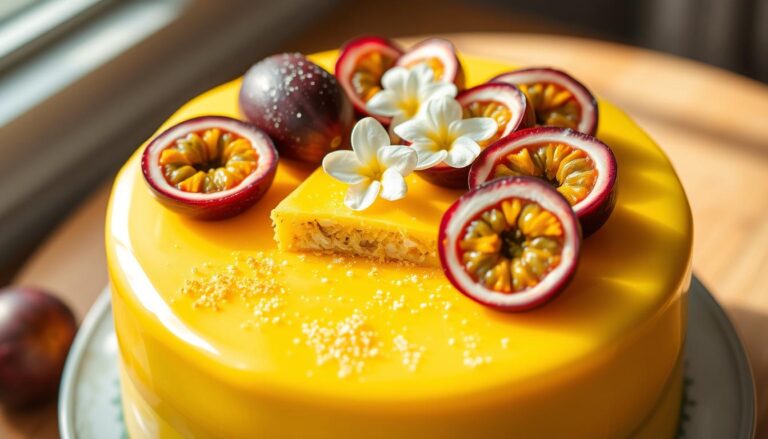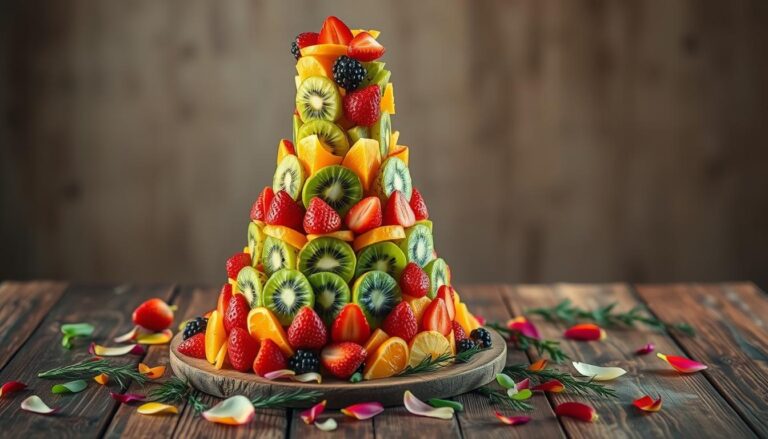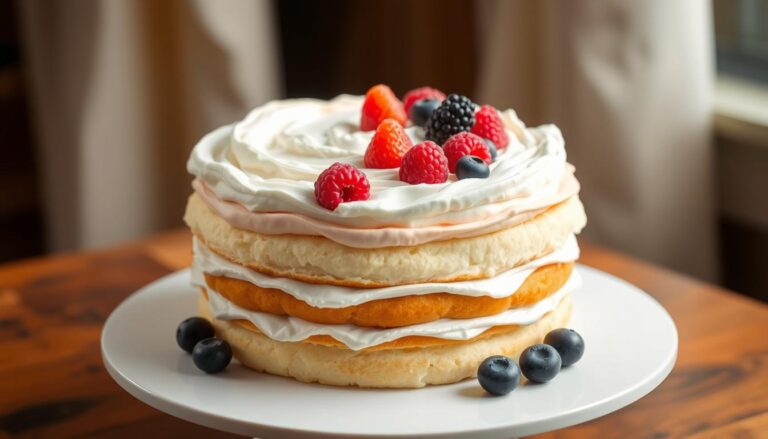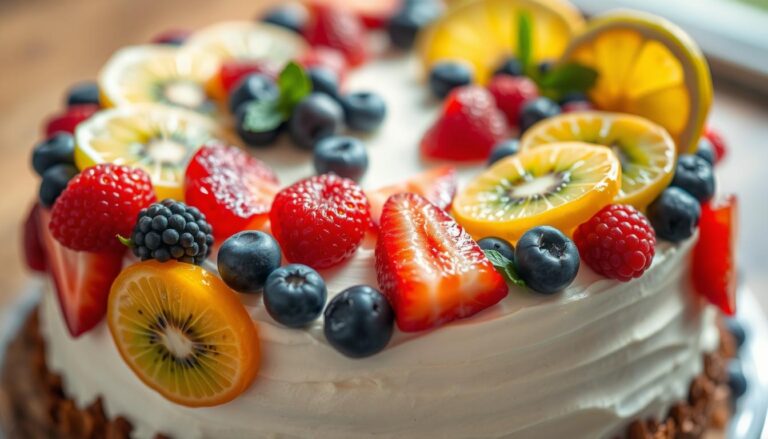How to Decorate a Cake with Fruit on Top: Tips for a Stunning Finish
Watching my grandmother decorate a cake with fruit was magical. She arranged strawberries, blueberries, and peaches with care. The cake looked like a masterpiece. This sparked my love for making beautiful fruit-topped cakes.
Decorating cakes with fresh fruit makes them special. It’s perfect for weddings, birthdays, or family gatherings. A fruit-decorated cake can make any dessert unforgettable.
This guide will teach you how to decorate cakes with fruit. You’ll learn about choosing the right fruits and decorating techniques. You’ll impress your guests with your delicious and stunning creations.
Table of Contents
Essential Tools and Materials for Fruit Cake Decoration
To make a stunning cake with berries, you need the right tools and ingredients. Start your journey by picking the perfect tools and ingredients. This will turn a simple dessert into a work of art.
Professional bakers know that the right supplies are key for fruit decoration. Let’s look at the essential equipment for a beautiful and tasty fruit cake.
Basic Equipment for Fruit Cake Decoration
- Offset spatula for smooth frosting application
- Turntable for easy cake rotation
- Sharp paring knife for precise fruit cutting
- Piping bags and tips for decorative elements
- Cutting board dedicated to fruit preparation
Recommended Fruit Selection
| Fruit Category | Best Seasonal Options | Decoration Suitability |
|---|---|---|
| Berries | Strawberries, Blueberries, Raspberries | High – Vibrant colors, compact size |
| Tropical Fruits | Kiwi, Pineapple, Mango | Medium – Unique shapes and flavors |
| Stone Fruits | Peaches, Cherries, Plums | Medium – Soft textures, beautiful colors |
Additional Decorating Supplies
Add extra flair to your seasonal fruit cake with these items:
- Edible flowers for elegant garnishing
- Fresh mint leaves for color contrast
- Clear fruit glaze for shine
- Food-safe tweezers for precise placement
With quality tools and the right fruits, you’re ready to make a stunning cake. It will wow everyone with its looks and taste.
Preparing Your Cake Base for Fruit Decoration
Starting a naked cake with fruit means mastering some basic baking skills. Your cake’s base is key to how your fruit-adorned birthday cake looks and tastes. You need a strong, even surface to hold up your fruit decorations.
First, pick a cake recipe that fits your fruit. Vanilla, lemon, or almond cakes are great. They let your fruit decorations stand out.
- Level your cake layers using a serrated knife
- Create a smooth, even surface for fruit placement
- Ensure cake layers are completely cooled before decorating
The crumb coat is essential for a naked cake with fruit. It’s a thin layer of frosting that keeps crumbs in and provides a solid base. Refrigerate your cake after the crumb coat for about 15-20 minutes to set the initial frosting layer.
“A well-prepared cake base is the secret to stunning fruit decorations” – Professional Pastry Chef
When you’re getting your cake ready, think about how sturdy it needs to be. Cakes like pound cake or dense sponge cakes are best. They can handle the weight of fresh fruits. Avoid cakes that are too soft or crumbly.
- Choose dense cake recipes for stability
- Chill cakes before decorating to improve firmness
- Use a sturdy cake board for additional support
The aim is to make a beautiful base for your fruit decorations. It should be strong, yet delicious.
The Importance of Temperature Control in Cake with Fruit on Top
Creating a stunning fruit-crowned pastry needs precise temperature control. It’s key to understand how temperature affects both the cake and fruit.
Professional bakers know temperature is vital for a perfect cake look. Your cake’s temperature can make or break the decorating process.
Optimal Cake Temperature
Before decorating, make sure the cake is completely cool. Warm cakes can cause big decorating problems:
- Frosting will melt quickly
- Fruit toppings may slide off
- Structural integrity becomes compromised
Fruit Storage Guidelines
Proper fruit storage is key for a great fruit layer cake. Follow these important tips:
- Refrigerate fresh fruits at 40°F or below
- Wash fruits just before use
- Pat fruits dry to prevent excess moisture
- Store prepared fruits in airtight containers
Working Time Considerations
Time management is key when decorating with fresh fruits. Work fast to keep fruits looking fresh. Prepare all ingredients and tools before starting, and work in a cool place to keep decorating going longer.
“Cold ingredients and a cool workspace are the secrets to a perfect fruit-topped cake.” – Professional Pastry Chef
Choosing the Right Frosting Foundation
Creating a stunning fruit garnished dessert starts with the right frosting. The perfect frosting gives your cake both support and flavor. It’s key to a beautiful cake with fruit on top.
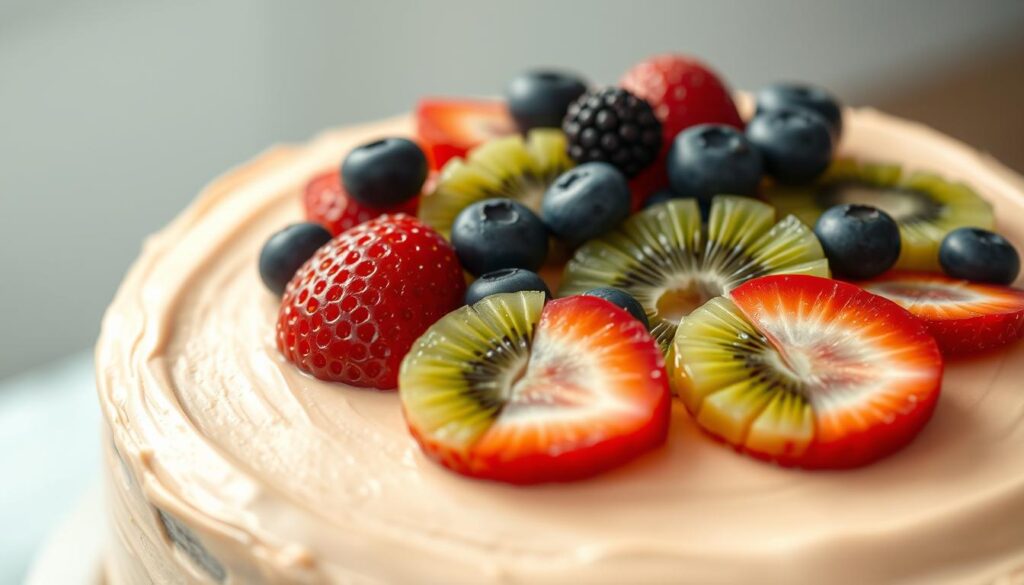
When picking a frosting, think about how it affects your cake’s look and stability. Each frosting has its own traits that can help or hinder your fruit decoration.
- Buttercream: Provides excellent stability and smooth surface
- Cream cheese frosting: Offers rich flavor and moderate firmness
- Whipped cream: Delicate but less reliable for fruit placement
Professional bakers say buttercream is the best for fruit desserts. It’s strong and lets you place fruit exactly where you want.
| Frosting Type | Stability | Fruit Compatibility |
|---|---|---|
| Buttercream | High | Excellent |
| Cream Cheese | Medium | Good |
| Whipped Cream | Low | Limited |
Your frosting should make a smooth, even surface. This surface supports fruit decorations well. Try different methods to find the best way to present your cake with fruit on top.
Essential Fruit Preparation Techniques
To make a stunning fresh fruit cake, you need to prepare the fruit well. The right steps can turn your cake from good to great. It makes the fruit look fresh and adds to the cake’s beauty.
Washing and Drying Techniques
- Rinse fruits under cool running water
- Use a soft brush for delicate fruits like berries
- Pat dry with clean paper towels
- Avoid soaking fruits to prevent moisture damage
Cutting and Shaping Strategies
When cutting fruits for cake decoration, precision is key. Use sharp tools to get even slices and shapes. Each fruit needs a special way to cut:
- Strawberries: Slice from top to bottom for elegant fan designs
- Kiwis: Cut into thin rounds or quarter-moon shapes
- Citrus fruits: Remove membrane for clean, translucent segments
Preventing Fruit Oxidation
To keep your cake looking fresh, stop browning. Quick methods can keep fruit colors bright:
- Brush cut fruits with lemon juice
- Use a light sugar syrup coating
- Work quickly after cutting
- Refrigerate decorated cake immediately
Learning these fruit prep techniques will make your cake look amazing. It will be both beautiful and tasty.
Creating Beautiful Fruit Patterns and Designs
Turning a simple fruit layer cake into a masterpiece needs creativity and planning. Your fruit-crowned pastry can become a stunning work of art with the right design. This includes choosing the right techniques and approach.
When designing your cake’s fruit arrangement, consider these key strategies:
- Create concentric circles using vibrant fruits like berries and citrus slices
- Develop radial patterns that draw the eye toward the cake’s center
- Experiment with fruit mosaic designs for an eye-catching look
Professional bakers say to think about color balance and visual composition. Your fruit decorations should match the cake’s frosting and overall look. Try these innovative design approaches:
- Craft three-dimensional fruit flowers using carefully sliced grapes
- Build sculptural fruit shapes that add height and drama
- Incorporate edible flowers or herbs for a unique texture
Some unique techniques can make your cake stand out. For example, create tiny fruit “candles” with blueberries and pineapple chunks. You can also make delicate grape flowers by making careful cuts and adding a blueberry center.
Remember, practice makes perfect. Each cake is a chance to try new fruit arrangement styles. This shows off your creativity and culinary skills.
Professional Tips for Securing Fruit Decorations
Making a stunning cake with fruit on top is more than just placing them nicely. It’s about securing them well. This makes your cake look professional.
Professional bakers see fruit decoration as both art and science. They aim to make a design that looks great and stays in place. This is true even when you move or serve the cake.
Adhesion Methods to Keep Fruits Secure
- Use cream cheese frosting as a natural fruit adhesive
- Apply a thin layer of apricot glaze for extra hold
- Utilize buttercream as a “glue” for fruit placement
Stabilizing Techniques for Heavier Fruits
Heavier fruits can be tough on your cake. Here are some pro tips:
- Create a base layer with firmer fruits like apple or pear slices
- Use toothpicks sparingly to anchor larger fruit pieces
- Chill the cake briefly to help set fruit decorations
Layer Building Strategies
| Fruit Type | Best Placement Strategy | Recommended Technique |
|---|---|---|
| Berries | Top layer | Gentle press into frosting |
| Citrus Slices | Middle or edge layers | Overlap slightly for visual interest |
| Tropical Fruits | Strategic placement | Use as focal point decorations |
Using these pro techniques will make your cake look amazing. Remember, being patient and precise is key. This will help you create a fruit-adorned birthday cake that wows everyone.
Seasonal Fruit Selection and Combination Ideas

Creating a stunning fresh fruit topped cake starts with picking the right seasonal fruits. Each season brings its own set of fruits that can make your dessert a masterpiece.
Spring offers delicate and vibrant fruits that can make your cake pop:
- Strawberries with their bright red color
- Delicate raspberries in soft pink tones
- Tender cherries for a pop of color
Summer brings juicy and colorful fruits perfect for decorating:
- Ripe peaches with golden-orange hues
- Blueberries for deep purple accents
- Tropical mangoes for an exotic touch
When picking fruits for your cake, think about these things:
- How well they taste with your cake base
- How they look together
- If they stay firm and don’t fall apart
Fall and winter offer rich, deep fruits for elegant designs. Figs, pomegranate seeds, and persimmons add color and texture to your cake.
Pro tip: Try mixing fruits from different seasons for unique designs. They’ll surprise and delight your guests.
Glazing Techniques for a Professional Finish
To make a fruit-crowned pastry stand out, you need more than just arranging the fruit. The key is a professional glaze. It adds shine and keeps your fruit decorations safe.
Glazing techniques can turn a simple cake into a work of art. Professional bakers use different methods to get that perfect finish. Here are a few:
- Apricot glaze for a classic transparent shine
- Simple syrup for moisture and subtle sweetness
- Gelatin-based glazes for long-lasting protection
- Fruit preserve glazes for additional flavor
To glaze your fruit-crowned pastry right, follow these steps:
- Make sure your cake is completely cool
- Use a soft pastry brush for even application
- Apply glaze gently to prevent fruit displacement
- Work quickly to maintain fruit freshness
Pro tip: Warm your glaze slightly to create a more fluid consistency that spreads smoothly across your fruit decorations.
Each glazing technique has its own benefits. An apricot glaze gives a clear finish, while a gelatin glaze offers strong protection. Choose the right method based on your dessert and presentation goals.
Troubleshooting Common Fruit Decoration Challenges
Decorating a naked cake with fruit can be tricky, even for experienced bakers. Unexpected challenges can pop up during the cake decoration process. This can turn your beautiful creation into a disaster. Knowing common issues and their solutions will help you create stunning berries on cake designs with confidence.
When working with fresh fruits, several problems can arise. These might affect your cake’s appearance and taste. The key is to anticipate and address these challenges proactively.
Preventing Fruit Bleeding
Fruit bleeding can quickly ruin your cake’s look. To prevent this, consider these strategies:
- Pat fruits completely dry before placing on cake
- Use a thin layer of cream cheese or buttercream as a protective barrier
- Select firmer fruits like strawberries and blueberries
- Avoid overly ripe or soft fruits
Addressing Common Issues
Fruit decorations can present unique challenges. These require quick thinking and creative solutions.
| Issue | Solution |
|---|---|
| Slipping Fruit | Use a light layer of frosting as glue |
| Wilting Berries | Replace with fresh fruits immediately |
| Uneven Placement | Use tweezers for precise positioning |
Quick Fixes for Decorating Mistakes
Don’t panic if something goes wrong while decorating your berries on cake. Professional bakers know that creative problem-solving can turn disasters into unique design elements.
- Cover imperfections with additional fruit garnishes
- Strategically place mint leaves to hide minor flaws
- Rearrange fruit to create a more balanced look
- Use powdered sugar to mask small errors
Remember, practice makes perfect. Each cake decoration experience will improve your skills and confidence in creating beautiful fruit-adorned desserts.
Conclusion
Decorating a cake with fruit on top makes it a stunning masterpiece. Your journey in fruit decoration is just starting. You’ll create amazing fruit-adorned birthday cakes that wow everyone.
Practice makes you more confident. Every cake you decorate improves your skills. You’ll find new ways to arrange fresh fruits.
Fruit decoration is all about being creative and spreading joy. It’s fun for both beginners and experienced bakers. Enjoy the process, not perfection.
Your culinary journey keeps going with every slice you make. Learn, trust your instincts, and have fun with fruit cake decoration.


